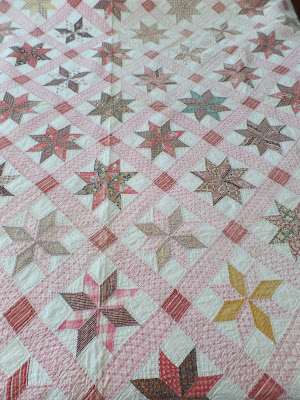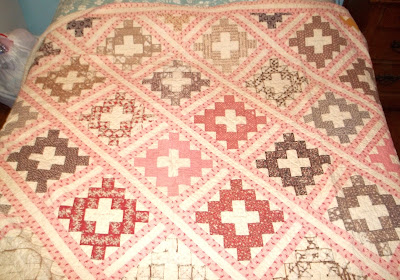Happy Thursday!
Here's a little backing humor:
Some antique Pennsylvania quilts have plain muslin backings.
This Lemoyne Star, circa 1845, has a plain muslin back:
I've had people tell me that they think this was not made in Pennsylvania because of the backing. I've had people tell me that it resembles a quilt from New England. But we might want to take into consideration some other factors.
Muslin backings might have not been often used by the PA Germans but there were plenty of other ethnicities in our state. It may be easy to distinguish a Pennsylvania German quilt but not a quilt made in Pennsylvania.
Two cities in our valley were founded by Englishmen. Early settlers to our region included English, Irish, Wales, Switzerland, Alsace (sometimes Germany, sometimes France), some areas of Germany, and Bohemia/Czechoslovakia (as in Moravians who founded our valley's city of Bethlehem and moved to Germany to escape religious persecution before coming here).
Early Pennsylvania Germans preferred woven coverlets over quilts. There was a whole tradition of weaving here in our state (and others) and in just about any flea market you can find examples.
In the mid-19th century, Pennsylvania Germans learned quilting from their "English" neighbors. I've read that after one generation, weaving was abandoned all together for quilts.
So getting back to those muslin backings....
Another quilt in my collection, similar to the one above also has a muslin backing:
The top of the quilt was made circa 1840. My appraiser speculated that the quilt might have been completed after the Civil War. The backing is machine pieced and sewing machines were more readily available after the Civil War. But who really knows?
The city of Allentown was already affluent and remained so during the Civil War, earning the name "The Queen City". There were so many varied industries in the area that the economy remained stable before and after the war. The variety of different industries were considered the "jewels" in the crown. A remarkable aside is that if one company had to face lay-offs, another factory often came in to pick up the workers.
Accounts of women working as the Sanitary Commission illustrated that sewing machines were also used in some way. There are lots of stories of so-and-so's machine being used at the church for the things the women were sewing.
Two other 19th century notable quilts in my collection have muslin backings. Both were signature quilts; the second I am certain was a fund raising quilt.
Judging by the fabric, names, birth/death dates, this was made before the Civil War. The quilt originated west of us, in the coal mining areas where my Mom grew-up.
Zig-Zag Fundraising Quilt, circa 1890
It is possible, possibly probable, that muslin was used on the back of these two later quilts simply to save money for whatever causes either of these quilts were meant to support.
Still, there is another possibility that must be voiced as well. Betsy G. who is a friend and also sometimes shares things on the blog, had ancestors that moved to Pennsylvania from New England. If my memory is correct, I think that some of her family landed in Pennsylvania after state borders were changed.
All this is just a reminder that unless one has the full provenance of a quilt, that it's difficult to really know the origin of a textile.
Things are so much different now and have evolved to more homogenous quiltmaking. The charm of these quilts and the stories we like to speculate about them is part of the lure of studying old quilts. But it's always remember that the story is larger than just the fabric and styles we can identify.
Tomorrow is Friendship Friday. If you have anything you would like to share, please email me at allentownquilter@gmail.com
Have a safe and happy day!






.JPG)
.JPG)
No comments:
Post a Comment